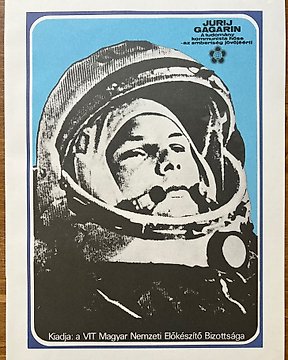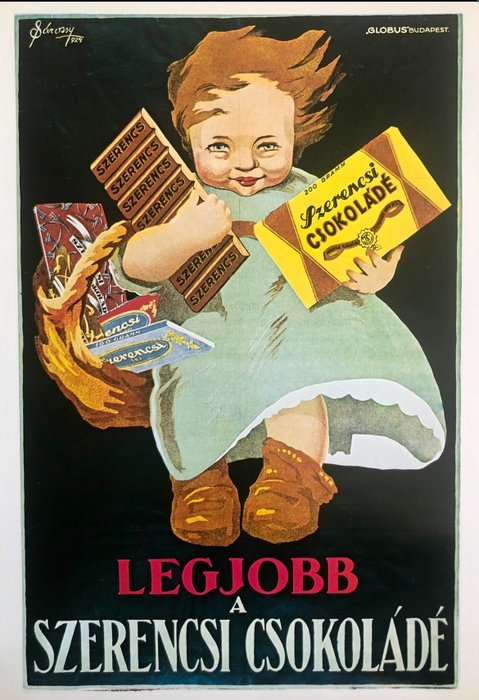
Gabor Gyarfas - 1973 Jurij Gagarin - NASA - space - Budapest - Hungary - Russian - USSR, - 1970-tallet
Nr. 80840315

Nr. 80840315

Poster 1979 official print of the Original emblematic chocolate adverisment.
-
Historical background
The confectionary industry of Hungary encountered serious problems after World War II: losses of the former mechanization, deficit of the needed raw materials, moreover, the fact that this industry was considered to be too luxurious for the weakened economy of the country. The industry was nationalized in 1948, as were numerous factories in the economic life of the country in the following Socialist era. There was no free market, but all the existing companies were integrated in the Hungarian Confectionary Industry Company which was controlled by the Socialist leadership. The production was centralized and it received a very low amount of money hence lower quality products were manufactured. Many different versions of chocolate were made with fancy names, however, there were no big differences. The ones available for the masses contained a lower percent of pure cocoa powder, and no cocoa butter as it was replaced by some cheaper, locally available plant oils. The lower quality products were usually artificially flavoured and sugary fillings were added to them in order to boost the taste. There were also chocolate bars without filling which needed to have a higher quality, and with the gradual rise of the industry the overall quality of the products was also improving. There was a statewide price reduction in the 1960s which made it possible for customers to afford the better quality products. It was accompanied by a clever marketing and skillful, humorous commercial propaganda which gained a huge popularity for these goods.
The Szerencsi chocolate brand was founded in the beginning of the 1920s. Its first product was pure, quality chocolate powder, but new ones soon appeared. Boci, a milk chocolate product of the company, was one of them. The factory had its own milk-farm to produce the neccessary milk for it. Tibi chocolate was found in 1941, by another famous chocolate company, named after Frigyes Stühmer. The brand had long traditions in Hungary, but just like the Szerencsi company, it was nationalized in 1948. Afterwards these companies weren't strictly differentiated since the question of production phases, creation of given products, etc. was decided by the political leadership, not by the company's own strategy.
—
About Hungarian Poster Art
Hungarian poster art has long been celebrated for its unique and captivating style, making it a significant cultural and artistic movement in the world. From the late 19th century to the present day, Hungarian poster art has left an indelible mark on the global art scene, with its innovative techniques, bold designs, and powerful messages.
One of the highlights of Hungarian poster art is its ability to seamlessly blend various artistic styles and influences. The movement drew inspiration from a wide range of sources, including Art Nouveau, Constructivism, and Surrealism, resulting in a diverse and eclectic body of work. Artists such as Mihály Bíró, József Bottlik, and István Irsai pushed the boundaries of traditional poster design, experimenting with typography, color, and composition to create visually striking and thought-provoking pieces.
Another notable aspect of Hungarian poster art is its emphasis on storytelling and narrative. Unlike many other countries' posters, which primarily served as advertising tools, Hungarian posters often conveyed a deeper meaning or social commentary. They were not just meant to sell products but also to engage viewers intellectually and emotionally. This storytelling approach allowed Hungarian poster art to transcend its commercial purpose and become a powerful medium for social and political expression.
The importance of Hungarian poster art in the world cannot be overstated. During the early 20th century, Hungary was at the forefront of graphic design, and its posters gained international recognition and acclaim. The Budapest School, a group of Hungarian artists, revolutionized the field with their avant-garde approach, influencing poster art movements across Europe and beyond. Their innovative techniques and artistic vision set new standards for poster design, inspiring generations of artists worldwide.
Furthermore, Hungarian poster art played a crucial role in shaping public opinion and mobilizing society. In times of political turmoil and social change, posters became a powerful tool for propaganda and activism. During World War II and the Hungarian Revolution of 1956, posters were used to rally support, convey messages of resistance, and document historical events. The ability of Hungarian artists to capture the spirit of the times and communicate complex ideas through visual imagery made their posters an integral part of the nation's cultural and political identity.
Today, Hungarian poster art continues to thrive, with contemporary artists carrying on the legacy of their predecessors. The Hungarian Poster Museum in Budapest showcases the rich history and evolution of this art form, attracting visitors from around the world. The enduring appeal and influence of Hungarian poster art can be seen in the works of renowned artists like Tibor Helényi and István Orosz, who have successfully merged traditional techniques with modern aesthetics.
In conclusion, Hungarian poster art stands as a testament to the country's artistic prowess and cultural heritage. Its unique style, emphasis on storytelling, and ability to provoke thought and emotion have made it an important and influential movement in the world. From its early beginnings to the present day, Hungarian poster art continues to captivate audiences and inspire artists, leaving an indelible mark on the global art scene.
—
Please note that our company was founded in 1994 and it is internationally trackable. Invoice is available upon request.
Our team consists of members with university degree of art, painting valuation experts and experienced art&antique dealers
Feel free to ask as much as you want. Lifetime warranty is available for all items originality.
Shipping is with insurance.
Hvordan kjøpe på Catawiki
1. Oppdag noe spesielt
2. Legg inn det høyeste budet
3. Å gjøre en sikker betaling